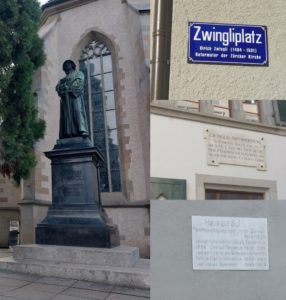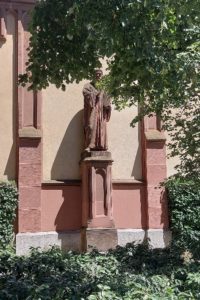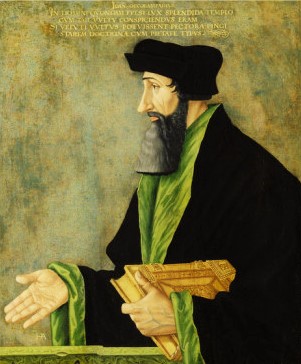I was visiting Zürich last summer for the Leverhulme project ‘The Correspondence of Huldrych Zwingli and Johannes Oecolampadius: Translation & Analysis’, so I could describe and analyse the original manuscript letters. Zwingli of Zürich (1484-1531) and Oecolampadius of Basel (1482-1531) are Swiss reformers, who started the reformation in their respective cities. Walking around Zürich, it was nice to see that Zwingli is everywhere. Over the door of the Grossmünster,

the church where Zwingli was pastor from 1519
until his death in 1531, you can read: ‘In diesem Gotteshaus nahm die Reformation Huldrych Zwinglis ihren Anfang’. The square it is on is now called ‘Zwingliplatz’ and numerous houses carry a plaque with information about Zwingli’s stay there. An impressive 19th-century statue to commemorate him can be found at the Wasserkirche, next to the river Limmat.
On my first Sunday in Switzerland, when the libraries were closed, I decided to visit Basel, Oecolampadius’s city. It is also the place where the famous Dutch humanist Desiderius Erasmus spent many years and died in 1536. I visited the Basler Münster, where Erasmus is buried. I had heard there are also monuments for Oecolampadius there. I found Erasmus’s gravestone very soon – it is a lavish monument, engraved with golden letters and can be found in the Münster itself. I had to search a bit longer for Oecolampadius. There is a commemorative plaque with inscriptions on three notable Basel figures, including the reformer, in the cloisters, where hundreds of inscriptions
can be found. I had heard there was also a statue of him, but could not find it anywhere. As I was walking round the Münster for a final look after my visit, I spotted it… No wonder I had not seen it before! It was hidden behind a tree, and to see it properly I had to stand between the plants in the plot that surrounded the tree. I also visited the Martinskirche, Oecolampadius’s church in Basel. To my surprise there was no mention of him there either. There was only a small, recent plaque about his wife, Wibrandis Rosenblatt (1504-1564), who was married to Oecolampadius from 1528 to 1531 and was thereafter married to the Strasbourg reformers Wolfgang Capito (c. 1478-1541) and Martin Bucer (1491-1551).
My quest for traces of Oecolampadius reflects his position in accounts of the Swiss reformation more generally. While

Zwingli is well-known, many texts on the reformation do not even mention Oecolampadius. Yet, as the correspondence reveals, and scholars such as Amy Burnett and Jeff Fisher have argued, Oecolampadius shaped many of the views which are today considered Zwinglianism. We hope that our English edition of the correspondence between Zwingli and Oecolampadius will contribute to restoring the Basel scholar and reformer to his rightful place!
